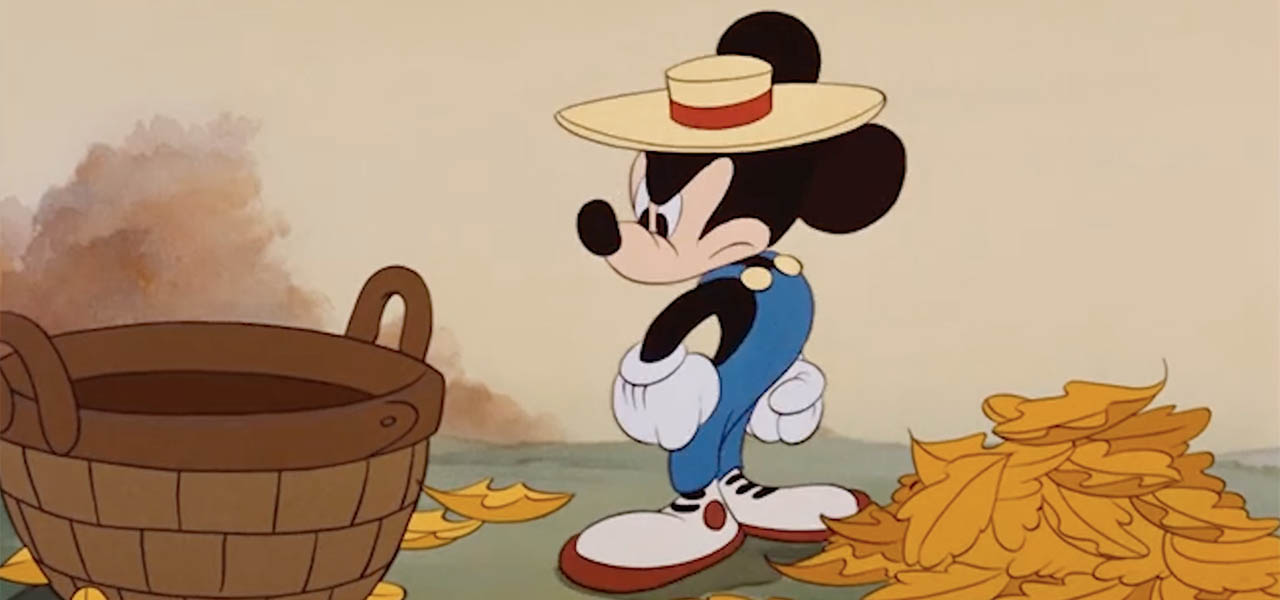The Nine Old Men, a name Walt Disney gave to his core animators in the 1950s, were undeniably brilliant. Still, I’ve always felt that the artists who defined Disney’s style who were no longer at the studio when Walt coined the “Nine Old Men” title – among them Art Babbitt, Bill Tytla, and Norm Ferguson – don’t get the attention they deserve. And so much of what we think of as the Disney style goes back to the work of the great Fred Moore (1911-1952), usually called “Freddie” around the studio.
Legendary animator Marc Davis once said, “Fred Moore was Disney drawing. We’ve all done things on our own, but that was the basis of what Disney stood for.” Throughout the 1930s, Moore’s bouncy, joyful animation set the standard other Disney animators sought for. He sadly died in a car accident at an early age, and so was rarely interviewed, but his vibrant personality shines through his work. Look at the way this Mickey Mouse scene he animated in The Little Whirlwind (1941) just oozes charm.
— Cartoon Study (@CartoonStudy) November 12, 2024
Moore started at Disney in 1930 at just 18 years old. He had little formal training, but his peers were impressed by his natural drawing ability. His breakthrough as an animator – and one of the significant breakthroughs for Disney in general – was his work in The Three Little Pigs (1933). Looking at it today, it can be hard to appreciate what an innovation this rather straightforward scene of singing pigs was at the time. Earlier cartoon characters often moved like they were made of rubber (a style that I also love), while attempts at realism came off as stiff and jerky. What Moore managed to do was maintain his characters’ central volume while applying squash-and-stretch, making his creations soft and fleshy instead of rubbery. In Moore’s hands, the pigs seem tangible and dimensional without sacrificing any cartoony exaggeration. Walt Disney was highly pleased with his work, and declared, “At last, we have achieved true personality in a whole picture.”
— Cartoon Study (@CartoonStudy) November 12, 2024
Moore was particularly adept at animating chubby little fellows with big flabby jowls, making him the perfect choice to design and animate the seven dwarfs in Disney’s first feature-length cartoon. Moore drew the final model sheets of the dwarfs and established how they would move in the lengthy scene where they are introduced to Snow White. “Appeal” is the word that comes up the most when talking about Moore’s style, and it’s true that the doughy squishiness of his work makes it just plain fun to look at, but his incredible skill at character animation might be even more impressive. Every little nuance and gesture of each dwarf tells you so much about their personalities, like they’re all being played by seasoned character actors. The fact that one man animated all seven dwarfs in this scene is truly staggering (Ham Luske animated the shots of Snow White here).
— Cartoon Study (@CartoonStudy) November 12, 2024
Moore was famous around the studio for his pin-up drawings, referred to as “Freddie Moore Girls,” and some of them even made their way into films; for example, the centaurettes in Fantasia and the mermaids in Peter Pan were designed and animated by Moore. The “All the Cats Join In” segment of Make Mine Music (1946), in which hepcats jitterbug to Benny Goodman and his Orchestra, was designed by Moore in the style of his own personal sketches. (Apologies for the censorship in the Moore-animated clip below; the side of the woman’s breast was visible in the original release, but Disney has digitally scrubbed it out in contemporary releases.)
— Cartoon Study (@CartoonStudy) November 12, 2024
Moore’s approach is so synonymous with Disney that even when he animated for other studios, it suddenly feels like you’re watching a Disney cartoon the minute that Moore picks up his pencil. Look at the Mickey-esque likability he adds to this Andy Panda scene in the Walter Lantz short Dog Tax Dodgers (1948).
— Cartoon Study (@CartoonStudy) November 12, 2024
Moore was considered to be the Mickey Mouse expert at Disney. While drawing the model sheets for “The Sorcerer’s Apprentice” in Fantasia, he created the Mickey Mouse design still used today, updating the mouse with white circles around his eyes, flesh-colored skin, and a dimensional pear-shaped body. To my mind, Moore’s opening scene in The Nifty Nineties (1941) is the greatest animation of Mickey ever drawn (or at least second to Ward Kimball’s Mickey dance from Mickey’s Birthday Party). Every drawing flows into the next so beautifully that Mickey glides around with buttery smoothness. The poses are drawn with enviable confidence, and Mickey’s hands, feet, and tongue are extra-large here for maximum cartooniness.
— Cartoon Study (@CartoonStudy) November 12, 2024
Moore gave life to so many great characters (Lampwick from Pinocchio, Timothy Mouse from Dumbo,), but let’s turn it over to you. Do you have a favorite Fred Moore scene or character? Let us know in the comments below.
— Cartoon Study (@CartoonStudy) November 12, 2024

